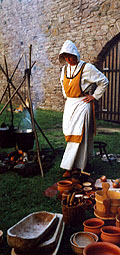Meet the Middle Ages
BackThe Peasants

During late Iron Age, only parts of the country were populated, large areas were completely uninhabited. During the early Middle Ages, people moved inland, to the forests. New land was cleared and farmed. In the old, inhabited districts there were villages. The people in the woods lived on single farms. Place-names with –ryd ( cleared land), -hult ( meadow) and –måla (claimed territory) indicate such settlements.
The expansion during the early Middle Ages continued until the second half of the 14th century. In the summer of 1350, the plague (the Black Death) struck Kalmar and by autumn it had reached the woods of Sevede. The effects of the plague were very severe, particularly so in areas with a small population. One effect of the plague was a decrease in farming during the latter part of the 14th and first part of the 15th century. The plague struck time and time again; in 1363-66, in 1393-99, in 1404-06 and in 1411-16. Farming did not pick up until the end of the 15th century.
Many of the Sevede farmers had their own property and paid taxes to the crown. They were free-holders, "skattebönder". The gentry owned land and property on the coast and on the borders. The farmers who farmed this land were tenant farmers –" frälsebönder". They leased the farm from the nobleman and paid taxes to him. The lease would usually be renewed every six years. When the lease was up for renewal, an additional fee was often claimed. It might have been rather more troublesome to have been a tenant farmer than a free-holder.The church, the bishop and the convents were land-owners, too. Their tenant farmers were called church- bishop- or convent-farmers. During the 15th century, many farms in Sevede were owned by the convent in Vadstena. The bailiff of the convent would regularly visit the district to collect taxes and to supervise the management of the farms.
The farmers in the Stångå Valley made their living by growing crops and tending livestock. They had fields of barley, rye or flax, as well as cattle. In the woods, the farm-land was poor. There the peasants had to try to make an additional living from forestry, charcoal-burning and the production of tar and iron. Iron was a very important income-source to these farmers and many of them were engaged in this production, particularly so during the 13th and 14th centuries. The districts surrounding Madesjö-Bäckebo and Gullabo-Karlslunda in Möre were at this time the busiest iron-producing areas of northern Europe. There was plenty of iron-production going on in Sevede as well.
The iron would be taken by horse-back or cart to Vimmerby. Then the iron was taken to Figeholm and then to Kalmar. From there it was shipped to the towns in northern Germany.
Nowadays, traces of the iron-production in the forests can be seen in the so-called "slag-heaps".
Read more about the iron-production in "Meet the Middle Ages" life in the country-side, work